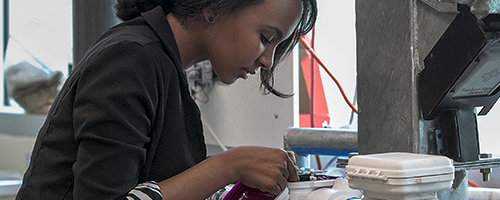Tom Kelley remembers taking the 19-mile drive down Interstate 10 in Los Angeles to school at the age of 14. On the way, he would pass a giant billboard that hung over the highway promoting whoever it was that was renting the space. He remembers passing it one day and seeing the board had been filled with a Nike advertisement featuring a fierce-looking Lester Hayes—then the cornerback for the Oakland Raiders.
Inspiring innovation
Tom Kelley remembers taking the 19-mile drive down Interstate 10 in Los Angeles to school at the age of 14.
On the way, he would pass a giant billboard that hung over the highway promoting whoever it was that was renting the space. He remembers passing it one day and seeing the board had been filled with a Nike advertisement featuring a fierce-looking Lester Hayes—then the cornerback for the Oakland Raiders.
He remembers thinking how incredible it would be to grow up to be the guy who got to make those advertisements.
Now, more than 20 years later, Kelley has become that person.
He’s the global brand director of sustainable business and innovation at Nike, has worked in both marketing and advertising at Wieden+Kennedy and was involved in innovative marketing for companies like Livestrong and Rhapsody.
On Monday at Portland State, Kelley lifted the curtain to expose the behind-the-scenes actions Nike is taking to inspire innovation and sustainability both in its business and throughout the world.
The presentation was the final installment of the Age of the Pacific Lecture Series this quarter, hosted by the Master of International Management program at PSU.
“It’s rare for people in marketing to be so heavily involved in the world of sustainability like Kelley [is], and Nike uses that to their advantage. We’re lucky to have him here,” said Cliff Allen, the MIM academic director.
Inspiring innovation was the key message of the night.
“That’s really what we’re focused on. To bring inspiration and innovation to every athlete in the world—and if you have a body, you’re an athlete,” Kelley said.
At its essence, Nike is devoted to great athletes, great products and great stories, he said. It’s about putting ourselves in a place to be advocates for the underdog and the athlete, Kelley said.
“My favorite product story is Michael Johnson and the golden shoes. The guy shows up in these glittery shoes…We wanted to make them lighter—and we did, they were 30 grams—but we took a brash point of view so people sat up and paid attention.”
Apart from selling products, Nike has been heavily involved in creating and organizing programs aimed at engaging the consumer and pulling them into a physically active lifestyle.
Programs like Run London, Run America and Nike’s Women’s Marathon are organized running events that unite thousands of runners from around the world. They’re aimed at encouraging a healthy, active lifestyle and are “done in the spirit of getting people out there and doing something,” he said.
In an ever-evolving world, business has reached the point where it can no longer operate the way it did in the past. A growing global effort to become more green and sustainable has driven Nike to transform the way it operates.
“The reality is, everything has changed. Our business model has changed. We have to break from our scarce resources to do what we do now, just in a different way,” Kelley said.
By designing product-creating processes that waste less and programs like Reuse-a-Shoe, which has recycled more than 28 million shoes and turned them into new shoes, basketball courts and other rubber products, Nike has taken strides to emphasize environmental consciousness in all of its business actions, Kelley said.





